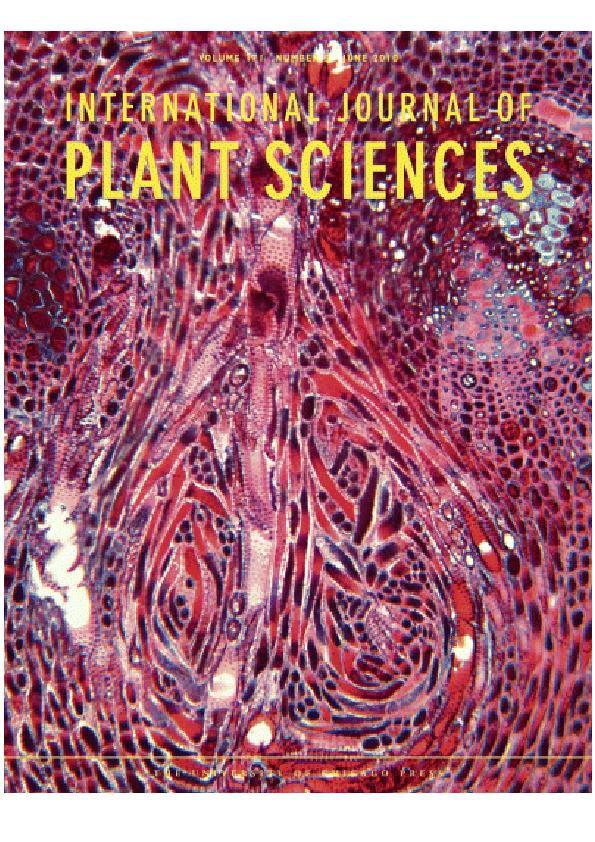Mostrar el registro sencillo del ítem
dc.contributor.author
Gonzalez, Ana Maria

dc.contributor.author
Mauseth, James D.
dc.date.available
2016-09-06T16:54:24Z
dc.date.issued
2010-01
dc.identifier.citation
Gonzalez, Ana Maria; Mauseth, James D.; Morphogenesis is highly aberrant in the vegetative body of the holoparasite Lophophytum leandrii (Balanophoraceae): All typical vegetative organs are absent and many tissues are highly modified; University Of Chicago Press; International Journal Of Plant Sciences; 171; 1-2010; 499-508
dc.identifier.issn
1058-5893
dc.identifier.uri
http://hdl.handle.net/11336/7480
dc.description.abstract
The vegetative body of Lophophytum leandrii is a ‘‘tuber’’ that completely lacks all vegetative organs typically found in photosynthetic plants. Tubers have a warty surface zone composed of parenchyma cells and brachysclereids; there is no epidermis. The interior of the tuber is a matrix of parenchyma cells and a ramified network of collateral vascular bundles. Ingrowths are abundant in vessels. Tubers grow diffusely by proliferation of parenchyma cells in the matrix and in vascular bundles and by a vascular cambium within each bundle. There are no apical meristems. The innermost portion of the surface zone is also a meristematic region, with warts enlarged by cell proliferation within their centers. The attachment point with Parapiptadenia rigida is a discrete woodrose: a ‘‘coralloid’’ interface caused by localized proliferation of host wood. Infection causes many changes in P. rigida wood development, most of which favor the success of the parasite. The only defensive reaction is that the host stops producing sieve tube members near the infection site. The woodrose and coralloid interface of L. leandrii seem to be intermediate between the simple interface of Helosis, and the elaborate chimeral interfaces of Balanophora and Langsdorffia.
dc.format
application/pdf
dc.language.iso
eng
dc.publisher
University Of Chicago Press

dc.rights
info:eu-repo/semantics/openAccess
dc.rights.uri
https://creativecommons.org/licenses/by-nc-sa/2.5/ar/
dc.subject
Balanophoraceae
dc.subject
Lophophytum
dc.subject
Morphogenesis
dc.subject
Organogenesis
dc.subject
Parasitic Plants
dc.subject.classification
Ciencias de las Plantas, Botánica

dc.subject.classification
Ciencias Biológicas

dc.subject.classification
CIENCIAS NATURALES Y EXACTAS

dc.title
Morphogenesis is highly aberrant in the vegetative body of the holoparasite Lophophytum leandrii (Balanophoraceae): All typical vegetative organs are absent and many tissues are highly modified
dc.type
info:eu-repo/semantics/article
dc.type
info:ar-repo/semantics/artículo
dc.type
info:eu-repo/semantics/publishedVersion
dc.date.updated
2016-07-26T15:07:32Z
dc.identifier.eissn
1537-5315
dc.journal.volume
171
dc.journal.pagination
499-508
dc.journal.pais
Estados Unidos

dc.journal.ciudad
Chicago
dc.description.fil
Fil: Gonzalez, Ana Maria. Consejo Nacional de Investigaciones Científicas y Técnicas. Centro Científico Tecnológico Nordeste. Instituto de Botánica del Nordeste (i); Argentina
dc.description.fil
Fil: Mauseth, James D.. University Of Texas; Estados Unidos
dc.journal.title
International Journal Of Plant Sciences

dc.relation.alternativeid
info:eu-repo/semantics/altIdentifier/url/http://www.journals.uchicago.edu/doi/10.1086/651947
dc.relation.alternativeid
info:eu-repo/semantics/altIdentifier/doi/http://dx.doi.org/10.1086/651947
Archivos asociados
